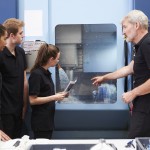“We’re trying to make it so people with disabilities have more opportunities for employment in society, right?” said Allison Lombardi, a professor who teaches in the Special Education Program at the University of Connecticut. “There’s not a separate society for just people with disabilities, so it really doesn’t make sense for us to create programs that are so separate.”
As a high school teacher in Pennsylvania, Shaun Dougherty noticed that students in career-focused programs seemed much more engaged than his other students. Now a researcher, Dougherty set out to see whether data backed up his experience. Could the programs not just prepare students for the workforce, but keep students from dropping out of school? To find out, Dougherty studied Massachusetts’ 36 vocational and technical high schools.
“During the 20th century, there was nothing that could help you achieve labor market success more than a good education. Even today, education is one of the strongest predictors of whether someone is employed and how much he or she is paid,” says Shaun Dougherty, assistant professor of education and public policy at UConn’s Neag School of Education.
Outside of large urban districts, regional vocational schools provide full-time CTE options. Massachusetts is a prime example, where Shaun M. Dougherty has done the best work. He uses an instrumental-variables approach to examine the impacts of these schools. And lest you doubt his sincerity in his belief of whether this approach provides plausible claims about cause and effect, see the title of his 2016 article, “The Effect of Career and Technical Education on Human Capital Accumulation: Causal Evidence from Massachusetts.”
“In one sense it makes sense to me politically that the small-government arm of the Republican party would be focused on reducing overall federal expenditures, especially in places like education that are supposed to be reserved for the state,” said Shaun Dougherty, a CTE researcher and education-policy professor at the University of Connecticut who authored the Fordham Institute report.
“If we want all of our young people to have the opportunity to thrive, it is more important than ever that high schools be designed to maximize the chances that students will graduate, and that when they do, they are prepared to enter college or have skills valued in the labor force,” says Shaun Dougherty.
Despite the education community’s clear polarization over the appointment of Betsy DeVos as the next U.S. secretary of education, there may be a silver lining in her confirmation—specifically, for those in the career and technical education (CTE) community.
Ask any group of high school teachers, and they will report that the most frequently asked question in their classrooms is, “When are we ever gonna use this?” In a traditional college prep program, the honest answer is usually, “Maybe when you get to the university.” But in the real world? Depending on the class, students may not find their learning as useful.
For more than a decade, school districts across the country have been revamping their career and technical education programs to better prepare students with the high-tech skills in demand today.
But as transformative as many of these so-called CTE programs have been, a new report by the Manhattan Institute for Public Policy and co-authored by Neag School assistant professor Shaun Dougherty cautions that there is much important work that still needs to be done.

